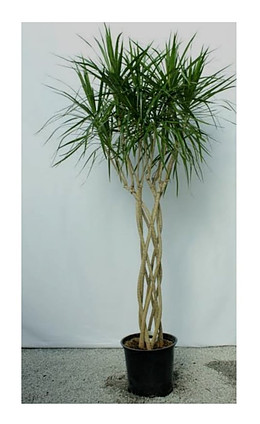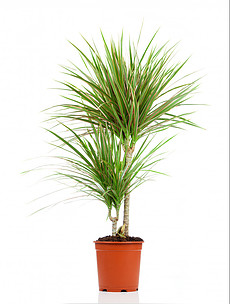You can find up to 40 species of dracaena. And with some snips and garden shears, you can trim all of them easily. While it isn’t compulsory to prune, it is exciting and gives you the power to shape the plant the way you want. Pruning dracaena is easy. Here are some useful tips on how to prune dracaena.

If you like, you can trim the stems and leaves to make the plant bushier and shorter. To put this in place, use sharp and clean pruning shears always, and prune your plants in the late summer and early spring.
Trimming dracaena plants generates a complete, strong plant, as two fresh branches (each with its own clump of leaves) or more will show up soon. The most favorable time to prune dracaena plants is the period during which the plant is growing actively in summer and spring. If possible, do not trim dormant dracaena plants in winter and fall.
Part 1 of 3
Strategic Pruning
1. Trim your plants ahead of the growing season.
In the second quarter of the year, the dracaena plant ends the rest mode and prepares for the blooming season. Pruning plants ahead of the growth period keeps them strong. Also, it makes shaping the plants into your chosen look easier.
- · Pruning your dracaena plants ensures fresh, healthy growth
2. Prune your plants again when the growth period is gone (during the late summer)
Get rid of stems or leaves after the growth period is gone (in late August). During the rest mode period (from fall to winter), the plants neither grow well nor produce leaves. To make the plants retain some energy, cut long stems or leaves ahead of the rest period.
- · With this, the plants can stay healthy and retain nutrients throughout the colder months
3. Use decent, sharp garden shears or knives when pruning your plants.
When trimming your plants, make sure to use a pruning shear or sharp blade. If you use a dead blade, this can affect the plant and make the healing process a challenge. Prior to making your cuts, use a disinfectant or rubbing alcohol to clean your garden shears. If you use a rough blade, this can cause the spread of disease and infection.
- You can, alternatively, use a pair of gardening scissors
Part 2 of 3
Trimming the Stems or Leaves
1. Use your hands to peel off any yellow or brown areas on the stems or leaves.
If you discover any weak leaves, you can use your fingers to remove them. Trim the leaves from the point of discoloration and retain just the green areas. Study around your plants and trim any unhealthy areas.
- If more convenient, use a pair of gardening scissors rather than your fingers
- This helps your plants look healthy and minimizes the risk of infection and disease.
2. Trim the leaves to make them look alike if you want uniformity.
If you’d like your leaves to look symmetrical or uniform, trim the leaves at some angles. Study the shape of the untrimmed leaves to ensure your leaves look reasonable.
- This way, there will be no traces of trimming the leaves
3. Cut off any unhealthy leaves extending out of the stem’s base.
Separate the leaves from the stem using your fingers, and prune the leaves using a pair of scissors. Repeat this for any wilted or brown leaves you notice.
- · Ensure your cuts are very close to the cane
Part 3 of 3
Cutting the Cane
1. Cut a stem if it’s losing its form.
Most times, some dracaena species have one main stem and a few extra stems. If any of the stems rest on one side and look ugly, use your pruning shears to remove the stem. You can remove it either to your chosen height or at the bottom of the plant to cut the entire stem. The stem will bring out a new height when it starts to grow a fresh branch.
- While this isn’t compulsory, your plants will keep looking compact and fresh
2. Remove the main stem at the top to form a small, bushy shape.
If you desire a compact, circular dracaena plant, remove the stem at the top using your pruning shears. Use your preferred height when making your cut, though it can range between one-quarter and three-quarters of the overall length of the stem.
- This helps fresh branches grow around the top of the stem
3. Do not cut your stem if you want the appearance to be wild and full.
Remember pruning is not compulsory with dracaena plants. If you love a wild and full plant, allow it to grow for the entire search and prune it the year after based on your preference. Allow the stems to grow and find out where the branches take their shape. You can customize your dracaena plants if you’d like.
- When you see your plants grow near the ceiling, you may consider trimming the leaves
4. Target an angle of 45 degrees, when cutting, to make the plant strong
Check your stem to see the direction of its growth, and shape your pruning shears to an angle of 45 degrees at the stem. To make a decent cut, tighten your pruning shears.
- This ensures quick healing of your plants and prevents the risk of infection
- Using a 450 angle cut, prune the stems to replant your clippings
5. Trim your stem to your chosen height.
Pruning the dracaena plants is based on individual preference. If you want to cut part of the branches, you can prune the whole stem. Or if you’d like to grow a smaller top, you can cut it in the middle.
- In pruning dracaena plants, there are no explicit rules
Conclusion
Dracaena is a genre of up to 40 adaptable, easy-to-grow plants with unique, strappy stems or leaves. Though dracaena is fit for cultivating outdoors in USDA plant resilience regions 10 and 11, it is constantly cultivated as a domestic plant.
Based on the grower, a dracaena plant may grow to heights of 3m (10 feet) or even longer. It is necessary to trim dracaena frequently. The awesome news is that it’s easy to prune dracaena plants.
These strapping plants condone pruning with little or no complaint, and you can reduce a dracaena plant to any favorite height.

Nina
I never knew it was that involved to prune a dracaena plant. You described the process very well, even down to the time of year. I never knew they could grow so far. I wonder if they’re safe for cats? I have 2 cats and would like to have a tall plant in my house. What do you think? Thanks for sharing.
admin
Hello Nina,
Thank you very much for your kind comment, and I appreciate your stopping by. I hope you find this helpful for your gardening. Thank you so very much.
Joyce
Michael
An interesting review. Dracena plants look great at a modest height, nominally around 120 cm or 4ft. give or take. At that height, they make a good indoor or patio plant.
One other thing about pruning them is to not prune them too close to the ground as they tend to die.
Nice post, thank you.
admin
Hello Michael,
Thank you so much for stopping by here on my website. Reading the article about How to Prune Dracaena Plant. Thank you for liking this article and the pruning guide.
Best wishes,
Joyce
hi
hi
Thank you for sharing your info. I truly appreciate your efforts and I am waiting for your next post thanks once again.|
admin
Thank you so much for reading and your stopping. Sure see you next.